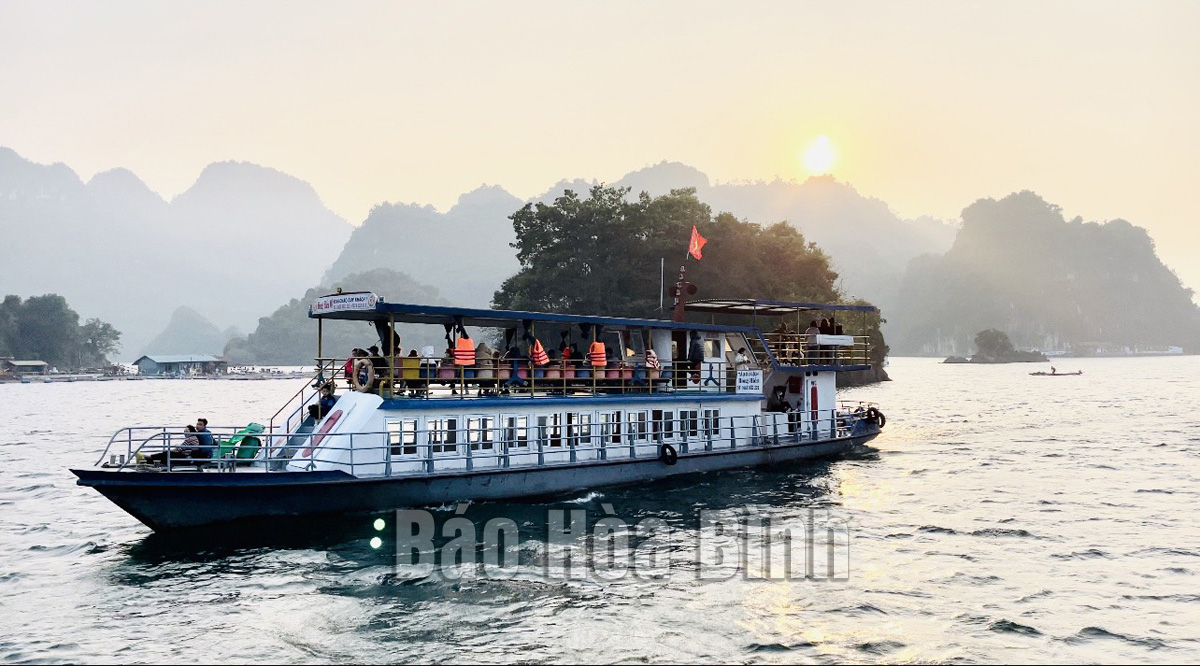
(HBO) – Hoa Binh lake, the biggest man made in Southeast Asia, is about 70km long, crossing 17 communes of one city and five district. It houses 47 large and small islands. The lake area features breathtaking landscapes, enticing cultures of different ethnic groups, and renowned spiritual tourist destinations.
Tourists explore Hoa Binh lake by boat on the Lunar
New Year holiday.
On August 1, 2016, the Prime Minister issued
Decision No. 1528/QD-TTg approving a master plan for developing the lake as a
national tourist area until 2030. On June 22, 2017, the Standing Board of the
provincial Party Committee issued Resolution No. 14-NQ/TU on the development of
the Hoa Binh Lake tourist area into a national one.
After half a decade implementing Resolution No.
14, the province has seen the lake area so far meeting three out of five
criteria set for a national tourist site. Many of its socio-economic
infrastructure projects have been completed, contributing to improving the
conditions of local travel, production and people’s livelihoods.
Currently, the Hoa Binh lake tourist area has
107 accommodation establishments, employing 1,200 workers. Its restaurants,
entertainment spots, tourist attractions, and tours have been built and
connected with localities in the province and country, creating a fairly
diverse tourism ecosystem attractive to visitors.
Every year, the province organises famtrip and
presstrip delegations to invite tourism associations, travel and media agencies
from other provinces to join hands promoting Hoa Binh’s tourism. Other measures
include connecting businesses for partnerships, and expanding tourist markets.
To date, there have been 18 projects worth some 3.5 trillion VND (147.58
million USD) in total approved for investment in the Hoa Binh lake area.
In order to meet remaining criteria for the area
to be recognised as a national tourism site by 2025, Hoa Binh is working to
attract investment projects serving the development of accommodation facilities
rated three stars and above; promoting community-based tourism; tackling investors’
obstacles; and running communications campaigns for raising public awareness on
tourism promotion and environmental protection./.
A diverse chain of eco-tourism and resort destinations concentrated in Hoa Binh city and the districts of Tan Lac, Da Bac, and Luong Son… Along with the launch of several key high-quality resort tourism projects, these developments have reshaped the landscape and enhanced the appeal of Hoa Binh as a travel destination.
Boasting diverse terrain, a mild climate, and rich natural resources, Cao Phong district is increasingly asserting its place on Vietnam’s tourism map, attracting both domestic and foreign visitors. The district is renowned for its stunning landscapes, majestic mountains, a crystal-clear hydropower lake, and the unique cultural identity of local ethnic groups.
With its pristine landscapes, unique cultural heritage of Muong ethnic minority, and an expanding range of visitor experiences, Tan Lac district of Hoa Binh has fast become a captivating destination for both domestic and international tourists.
Until now, Sung village in Cao Son commune, Da Bac district remains the only Dao ethnic community in Hoa Binh province to develop a community-based tourism model. Beyond its untouched natural landscapes, cultural identity serves as the cornerstone attraction for visitors.
Alongside the diverse cultural identities of the Kinh, Muong, Tay, Thai, Dao, and Mong ethnic people, Hoa Binh province is also renowned as the "capital" of the northwestern Vietnamese cuisine, offering unique and distinctive dishes. At festivals, during Lunar New Year (Tet), or on significant family or community occasions, special dishes are prepared, leaving a lasting impression on visitors.
A Phong Linh (Yellow Tabebuia) flower garden in Thang village, Thach Yen commune, Cao Phong district is currently in full bloom, drawing a large number of visitors.



